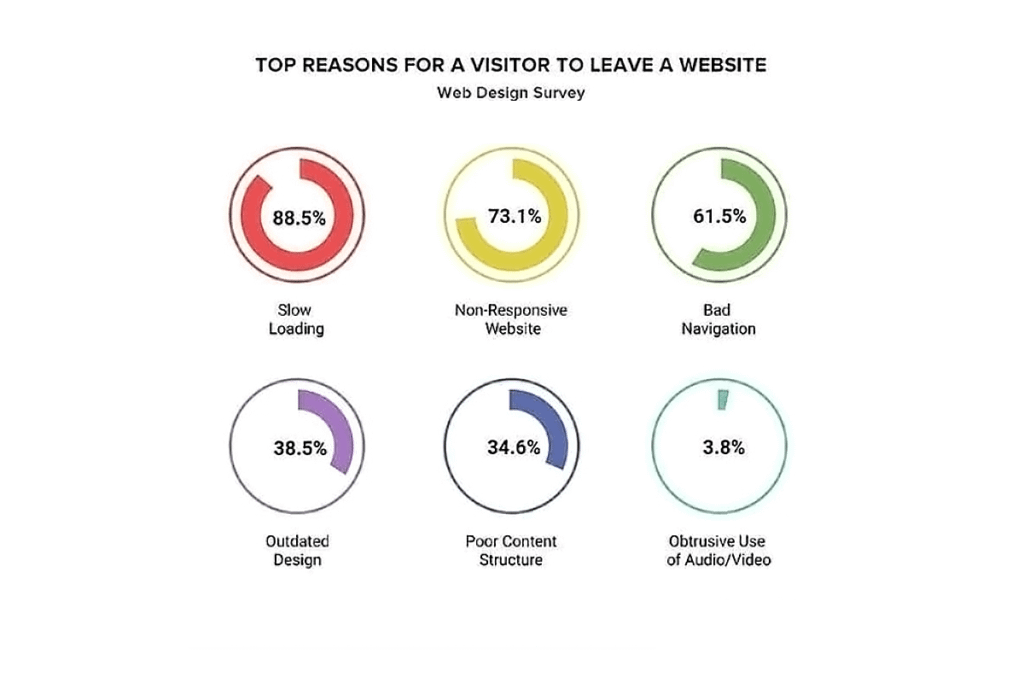The web is changing and so are the needs of users. The idea of a website as a static, unchanging entity is gone. Web design has to be responsive in order to provide a good user experience for all kinds of devices and screen sizes.
In the present time of the digital world, responsive web design is essential for businesses of all sizes. Building a responsive web design is a strategy that allows your website to automatically adapt to various devices, making it easier for users to view and navigate your site from their mobile.
But what are the key benefits of responsive web design, and what is the importance of responsive web design for your business? And how can you build it?
Let us jump into the article where we outline and discuss the concept in detail.
What is responsive web design?
The idea behind building a responsive web design is to create a single website template that can be viewed seamlessly on any device.

Responsive web design allows a website to adapt its layout to the viewing environment. It uses fluid layouts, flexible images, and CSS media queries.
Responsive web design is especially good for small businesses with limited resources because it reduces development time and effort in comparison to fixed-device layouts (like desktop browsers).
Online Accessibility Becomes a Necessity
The web is changing. The graph of mobile device users is increasing day by day, and this trend surely will only continue to grow, 6.4 billion smartphone users are identified around the world. 7 in 10 internet users say that they use mobile devices for product purchases. 65% of Indians prefer online shopping our traditional shopping.
After reading these stats do you really want to lose the opportunity to drive customers to your business?

So, it’s important that you make sure that your site works well on all devices (including desktop computers).
It’s not just about how many people are browsing from their phones—it’s about how well they can use what they’re seeing. If a user has difficulty navigating your site due to poor design or functionality, then he or she may give up trying altogether.
Importance of Responsive Web design for Businesses
Responsive design ensures that your website is optimized for all types of devices, from desktop to mobile. This is why in today’s digital world it is essential to know the importance of responsive web design.
It allows your website to be viewed on any device, regardless of the screen size, resolution, or device type. This helps to create a consistent user experience across all platforms and ensures that your website content is accessible to as many potential customers as possible.
Additionally, building a responsive web design can help you save time and money by reducing maintenance costs associated with multiple platform versions. If you are looking for ways to maximize your online presence and reach more people, responsive web design should be high on the list of considerations.

In 2015 it was announced by Google that mobile-friendliness would be one of the ranking factors in search engine algorithms. This could be a strong reason for building a responsive web design.
Let us dig in and check the other importance of responsive web design.
1. Better User experience:
The major importance of responsive web design is that it provides a better user experience since visitors can access the same content regardless of their device.
Responsive web design is becoming increasingly important in today’s business world, as it ensures that content is optimized for any device, from a desktop to a smartphone. Having a website that is optimized for different screen sizes and devices can significantly improve user engagement and satisfaction by allowing them to easily access the information they are looking for.
Furthermore, an effective responsive web design can result in improved website rankings on search engines, which can lead to higher traffic to the website and more potential customers.
All in all, building a responsive web design is an essential aspect of any successful online presence.
2. Boost your SEO:
Responsive web design also helps improve SEO rankings, as search engines prioritize websites that are optimized for mobile devices. This is because many users now access the internet through their phones or tablets, and non-responsive sites are harder to view on a smaller screen.
Optimizing for mobile ensures that users have a seamless experience when visiting a website, no matter what device they’re using. Responsive design also helps boost your SEO by making it easier for search engines to crawl and index your website.
Not only does it improve SEO rankings, but it also helps businesses reach a wider audience and stay competitive in the market.
3. More Cost-effective:
Responsive web design allows businesses to save time and money by only needing to maintain one website instead of separate versions for desktop and mobile devices.
Additionally, responsive web design is an invaluable tool for business owners and developers alike. It allows businesses to improve their visibility with an accessible website on any device, while also saving them time and money by only having to maintain one website.
Responsive web design is an essential piece of technology when it comes to the success of any website in today’s digital world.
4. Decreased Bounce Rate:
Bounce rate is the measure of how fast your users visit the website and decide to leave the website before reading the content. You may have great content but if your website is not responsive quickly on mobile devices, it is natural that the user gets pissed off and go for the next website.
Better navigation on different devices and quick loading of the website can definitely reduce the bounce rate.
Why Mobile Optimization?
Mobile optimization is essential for a successful website because more and more people are accessing the internet from their phones.
Studies say, more than 50 % of the traffic comes from mobiles. Responsive web design is a must for creating an optimal user experience when browsing with a handheld device. Responsive web design ensures that a website’s content and functionality are viewable without any scrolling, panning or re-sizing required.
It allows businesses to create a seamless transition as users move from desktop to mobile devices, as well as providing an optimal viewing experience regardless of the device being used. Taking the time to ensure that websites are responsive is crucial in today’s digital landscape, and will ensure that customers are able to easily access information or purchase products on their mobile devices.
Having a mobile-friendly website also helps to improve your search engine rankings, leading to more visibility and traffic Next, having a website that is responsive to different mobile devices is essential in today’s day and age.
Not only does it make the user experience more seamless and enjoyable, but it also allows businesses to remain competitive as many consumers today search exclusively on their phones and tablets.
Therefore, taking the time to ensure that your website is designed responsively can make all the difference in staying competitive in the modern marketplace.
Steps in building a responsive web design
1. Implement fluid grids:
A flexible grid is a more adaptable layout than a fixed one. Using percentages in place of pixels, it can be adjusted to fit any size or shape of content on your page and still maintain an overall aesthetic appeal.
A flexible grid allows you to break up the space with equal amounts of whitespace between elements so that they’re visually distinct from each other—like blocks on a chessboard or slices in an apple pie—and creates a visual hierarchy within your page flow.
This makes for a better user experience because users don’t have to scroll as much when viewing your site because they know where everything fits into place.
2. Use relative units:
Relative units are a great way to work with text sizes on your website. They allow you to change the font size for different elements without having to adjust all of your other settings at once.
Relative units are also easier to use than fixed units, so they’re a good choice if you want a responsive design that’s easy to use and maintainable.
3. Use CSS3 media queries:
Media queries are a way of making sure that your site looks good on different devices. They’re not just for mobile, either—you can use them in desktop and tablet views as well.
To use media queries:
- Create the CSS for your site and add the @charset rule at the top, right before any other code (this tells browsers what character set you’re using).
- Create a new rule called “media query” or something similar and then paste it into that same placeholder comment block where you added @charset.
- If you want to target particular screen sizes, add another rule within that first one: #my-screen-size { … } Add media queries based on widths–the most common ones being 320px wide and 480px wide–and heights–the most common ones being 768px tall (to match up with common laptop screens).
- Test out different stylesheets by changing values in those rules until they look good across all browsers
4. Build with mobile-first in mind:
Mobile-first is a design approach that starts with your mobile device and builds from there.
This can mean using media queries to target specific devices, or it could simply mean making sure that you are designing with your mobile users in mind from the start.
Conclusion
It is clear that responsive web design is an essential strategy for businesses of all sizes. By creating a website that is optimized for a variety of devices, businesses can benefit from increased website traffic and conversions, improved usability, and enhanced search engine rankings.
In an ever-evolving digital world, responsive web design is the key to success! Responsive web design is not a new concept, but it has become more important in recent years. If you want to attract your target audience and increase your chances of making a sale, then this is something that you should consider doing.





